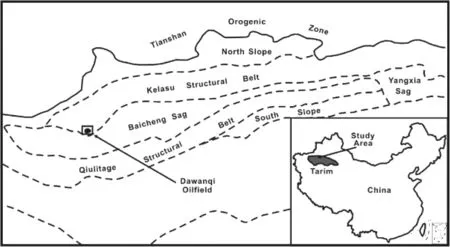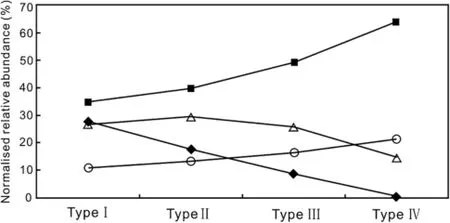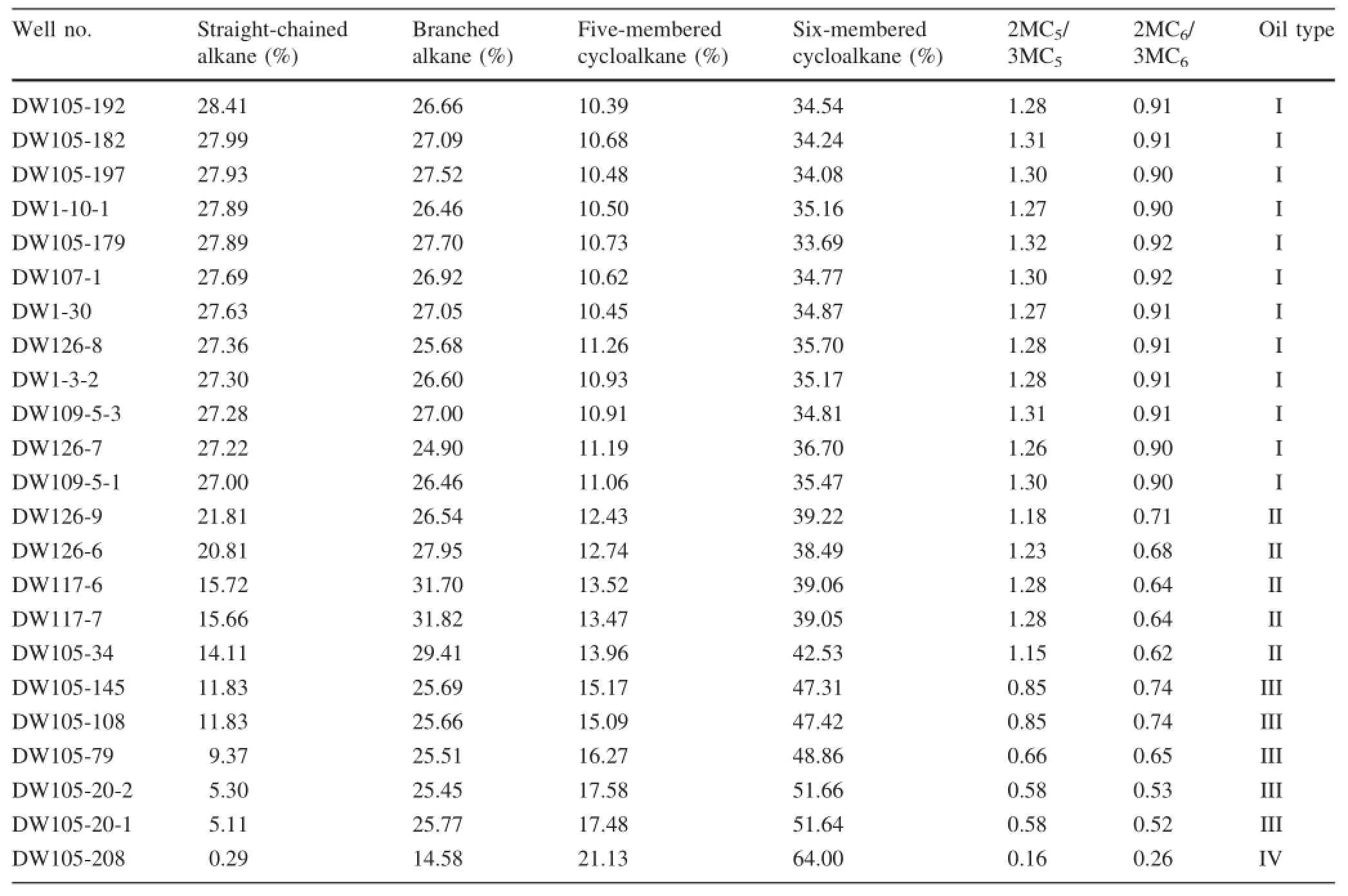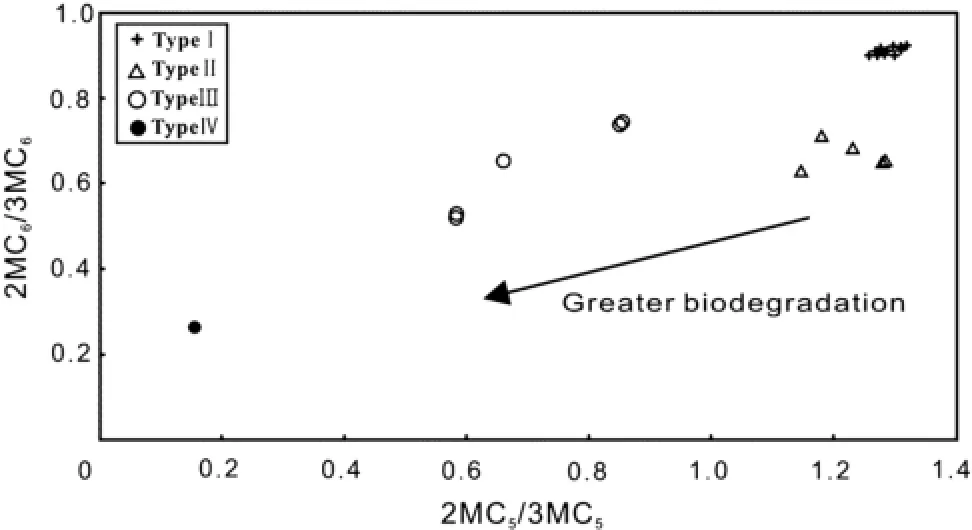The effect of slight to minor biodegradation on C6to C7light hydrocarbons in crude oils:a case study from Dawanqi Oilfield in the Tarim Basin,NW China
2016-10-20LuYangChunmingZhangMeijunLiJingZhaoXueningQiJinxiuDu
Lu Yang·Chunming Zhang·Meijun Li·Jing Zhao· Xuening Qi·Jinxiu Du
The effect of slight to minor biodegradation on C6to C7light hydrocarbons in crude oils:a case study from Dawanqi Oilfield in the Tarim Basin,NW China
Lu Yang1·Chunming Zhang2·Meijun Li1·Jing Zhao1· Xuening Qi3·Jinxiu Du4
Light hydrocarbons(LHs)are one of the main petroleum fractions in crude oils,and carry much information regarding the genetic origin and alteration of crude oils.But secondary alterations-especially biodegradation-have a significant effect on the composition of LHs in crude oils.Because most of the LHs affected in oils underwent only slight biodegradation(rank 1 on the biodegradation scale),the variation of LHs can be used to describe more the refined features of biodegradation.Here,23 crude oils from the Dawanqi Oilfield in the Tarim Basin,NW China,eleven of which have been biodegraded to different extents,were analyzed in order to investigate the effect of slight to minor biodegradation on C6-C7LHs. The study results showed that biodegradation resulted in the prior depletion of straight-chained alkanes,followed by branched alkanes.In slight and minor biodegraded oils,such biodegradation scale could not sufficiently affect C6-C7cycloalkanes.For branched C6-C7alkanes,generally,monomethylalkanesarebiodegradedearlierthan dimethylalkanes and trimethylalkanes,which indicates that branched alkanes are more resistant to biodegradation,with the increase of substituted methyl groups on parent rings. The degree of alkylation is one of the primary controlling factors on the biodegradation of C6-C7LHs.There is a particular case:although 2,2,3-trimethylbutane has a relative higher alkylation degree,2,2-dimethylpentane is more resistant to biodegradation than 2,2,3-trimethylbutane.2,2-Dimethylpentane is the most resistant to biodegradation in branched C6-C7alkanes.Furthermore,the 2-methylpentane/3-methylpentane and 2-methylhexane/3-methylhexane ratios decreased steadily with increasing biodegradation,which implies that isomers of bilateral methyl groups are more prone to bacterial attack relative to mid-chain isomers.The position of the alkyls on the carbon skeleton is also one of the critical factors controlling the rate of biodegradation.With increasing biodegradation,Mango’s LH parameters K1 values decrease and K2 values increase,the values of n-heptane and isoheptane decrease,and the indices of methylcyclohexane and cyclohexane increase. LH parameters should be applied cautiously for the biodegraded oils.Because biodegraded samples belong to slight or minor biodegraded oils,the values of n-heptane and isoheptane from Dawanqi Oilfield can better reflect and determine the‘‘Biodegraded’’zone.When the heptane value is 0-21 and the isoheptane value is 0-2.6,the crude oil in Dawanqi Oilfield is defined as the‘‘Biodegraded’’zone.
Crude oils·Light hydrocarbons· Biodegradation·Dawanqi Oilfield·Tarim Basin
This contribution has been accepted as a poster presentation in the 27th International Meeting on Organic Geochemistry.
✉ Chunming Zhang zhangcm@126.com
1State Key Laboratory of Petroleum Resources and Prospecting,College of Geosciences,China University of Petroleum,Beijing 102249,China
2Key Laboratory of Exploration Technologies for Oil and Gas Resources,College of Earth Environment and Water Resource,Yangtze University,Wuhan 430100,China
3Langfang Branch,Research Institute of Petroleum Exploration and Development,PetroChina,Langfang 065000,China
4Huabei Oilfield Company,PetroChina,Renqiu 062552,China
1 Introduction
Light hydrocarbons(LHs)are one of the main petroleum fractions in crude oils,especially for light oils in which commonly used biomarkers are usually present in extremely low concentrations or even under the detection limit of routine gas chromatography-mass spectrometry analyses(Peters et al.2005).
Benchmark research has suggested that LHs carry much information regarding the genetic associations and alteration of crude oils.It has been documented that LHs can be applied to oil-oil correlation studies,distinguishing genetic types of crude oils,and determining their thermal maturation levels(Williams 1974;Philippi 1975;Thompson 1983;Halpern 1995;Haven 1996;Chung et al.1998;Zhang et al.2005).However,secondary alteration-especially biodegradation-has a significant effect on the composition of LHs in crude oils.Based on the differing resistance of compound classes to biodegradation,Peters et al.(2005)developed a scale of 1-10 to assess the degree of biodegradation.Much work has been done on the effect of biodegradation on the molecular composition of crude oils(Volkman et al.1983;Connan 1984;Palmer 1993;Fisher et al.1998),whilst relatively little work has been done on the effect of biodegradation on the behavior of LHs.
Welte et al.(1982)demonstrated the preferential depletion of straight-chain alkanes relative to branched and cyclic alkanes during biodegradation and proposed two parameters(iso-pentane/n-pentane,3-methylpentane/nhexane)that could be used to indicate biodegradation. BeMent et al.(1994)suggested that 2,3-dimethylpentane is more subject to bacterial attack than 2,4-dimethylpentane. Masterson et al.(2001)showed that n-heptane,3-methylhexane,cyclohexanel and methylcyclohexane were more easily removed by biodegradation than benzene or toluene. George et al.(2002)suggested three main controls on the susceptibility to biodegradation(carbon skeleton,degree of alkylation,and position of alkylation).
Up to the present,details have been limited on the relative susceptibility of LHs to biodegradation.Because most of the LHs in oils underwent only slight biodegradation(rank 1 of the biodegradation scale),the variation of LHs can be used to describe more the refined features of biodegradation.Here,a total of 23 light oils from the Dawanqi Oilfield in the Tarim Basin(NW China)were analyzed to investigate the effect of slight to minor biodegradation on the distribution of C6-C7LHs.The resultscanbroadenthecurrentunderstandingof biodegradation effects on these low molecular weight hydrocarbons in crude oils.
2 Geologic setting
The Dawanqi Oilfield is located in the western margin of the Kuqa Depression,north of the Tarim Basin,NW China(Fig.1).The oil field covers an area of 5.4 km2with a proved oil reserve of 48.35×106bbl,with 13.64×109scf of dissolved gas(Zhao et al.2003).The Kuqa Depression is situated in the southern foot of the Tianshan orogenic Belt and is dominated by Mesozoic and Cenozoic deposits.This east-west trending depression,450 km long and 50-80 km wide and covering an area of about 2.8×104km2,is one of the most productive gas depressions in China.It contains the North and South Slopes,Baicheng and Yangxia Sags,and Yiqikelike,Kelasu and Qiulitage structural Belts(Graham et al.1993;Jiang et al.2010).The Dawanqi Anticline,situated in the western part of the Baicheng Sag,is composed of several normal fault blocks or broken anticlines separated by a number of normal faults(Zhang et al.2011).These faults,as pathways for oil migration,lead to the accumulation of oil and gas in traps under the gypsum salt(Tang et al. 2014).
Based on seismic,drilling and logging data,the sequence stratigraphic framework of Dawanqi Oilfield is:Paleogene Suweiyi Formation,Neogene Jidike,Kangcun and Kuqa Formations,and the Quaternary(Liu et al.2005).The Neogene Kuqa Formation is the most important prolific payzone in Dawanqi Oilfield.The Upper Triassic lacustrine shales/mudstones,thin coal seams formed in fluvial-deltaic and lacustrine environments,and the Lower-Middle Jurassic coal beds deposited in a swamp-lacustrine system were considered to be the main potential source rocks in the Kuqa Depression(Liang et al.2003;Zou et al.2006).
3 Samples and experimental procedures
Twenty-three light oil samples were carefully selected at wellheads from the Dawanqi Oilfield in the Tarim Basin. These samples were collected at temperatures between 25 and 30°,but were quickly refrigerated at below-6°(Canipa-Morales et al.2003).The production zones of these samples are 69.5-662.5 m deep.
Gas chromatography(GC)of the whole oil samples was performed on an Agilent 6890 gas chromatograph,equipped with two sets of electronic pressure controllers and a flame ionization detector(300°).A 50 m PONY capillary column was used with Helium as the carrier gas and a split ratio of approximately 50:1.The oven was programmed to an initial temperature of 35°for 5 min,followed by a heating ramp at 4°/min to 300°for 20 min.LHs were identified based on the GC analysis technique and byrelative retention times.The whole oil GC of C6-C7LHs in well DW126-8 and their qualitative analyses are shown in Fig.2 and Table 1,respectively.

Fig.1 Location map of the Dawanqi Oilfield in the Tarim Basin

Fig.2 Partial whole oil gas chromatograms of well DW126-8,showing the C6-C7region.Peak numbers are listed in Table 1
These crude oil samples have MPR values ranging from 0.96 to 1.17(RO≈0.88%-0.92%)(Table 2).They have similar thermal maturity.Their densities are commonly lowerthan0.8000 g cm-3,withaminimumof 0.7801 g cm-3.The variations in the relative amounts of fluorenes,dibenzothiophenes,and dibenzofurans from the oil samples are plotted on a ternary diagram from Li et al.(2013).As shown in Fig.3,all the data points are distributed in Zone 4,which shows that Dawanqi oils may originatefrombrackish/salinelacustrineshales.All Dawanqi oil samples belong to the same oil family.

Table 1 List of C6-C7light hydrocarbon in Dawanqi oils
4 Results and discussion
4.1 Gas chromatography of whole oils
Whole oil gas chromatograms show that Dawanqi oils are characterized by the distribution of light oil,with a predominance of low molecular-weight normal alkanes.In general,the crude oils in the Dawanqi Oilfield have the following distribution types(Fig.4;Table 2).
Type I The normal alkanes have a common range of carbonnumbersfromnC4to nC30,with a unimodalpattern maximizing at nC9or nC10,are observed.The values of nC21-/nC22+and nC13-/nC14+have a higher relative abundance(9.43-11.68 and 1.33-1.79).They are dominated by low molecular-weight normal alkanes.Most of crudeoilsinDawanqiOilfieldbelongtothistype(Fig.4a). Type II The normal alkane series of this type exhibit a common carbon number range of nC4to nC30and a bimodal distribution pattern,predominated by nC9and nC17.The value of nC21-/nC22+ranges from 3.32 to 6.40 and the value of nC13-/nC14+ranges from 0.29 to 0.95(Fig.4b). Type III The carbon numbers of normal alkanes range from nC4to nC30maximizing at nC14.The samples have a nC21-/nC22+value ranging from 4.35 to 5.27 and a nC13-/nC14+value between 0.40 and 0.56(Fig.4c).
Type IV There is no obvious n-alkane distribution in this type.Pristine and phytane have been depleted(Fig.4d).
Except Type IV,the values of pristane/phytane(Pr/Ph)values range from 1.90 to 3.06.Twenty-two crude oil samples have Pr/nC17values ranging from 0.10 to 0.18 and Ph/nC18values between 0.05 and 0.08.These two ratios show slight changes(Table 2).
Welte et al.(1982)proposed two LH ratios,3MC5/nC6and iso-pentane/n-pentane(iC5/nC5),to identify biodegradation.In the major crude oils(Type I),there are lower relative ratios of 3MC5/nC6and iC5/nC5(0.35-0.37 and 0.79-0.93).In contrast,from type II to type III,these two ratios increase gradually(0.48-2.86 and 0.95-2.51),which shows that crude oils from the Dawanqi Oilfield are characterized by obvious biodegradation.In type IV oils,nC5was totally depleted(Fig.5;Table 2).
Based on the above analyses,as reported by Yang et al.(2015),the Dawanqi oils from shallower depth usually show biodegraded characteristics.Type I oils are non-degraded oils.Type II oils and Type III oils belong to slight biodegraded oils(rank 1 on the degree of biodegradation scale),and Type IV oils belong to minor biodegraded oils(rank 3 on the degree of biodegradation scale)(Peters et al. 2005).From Type I to Type IV,the extent of biodegradation exhibits a marked tendency to increase.
4.2 Effect of biodegradation on C6-C7light hydrocarbons
A total of 23 homologues and isomers of C6-C7LHs,includingstraight-chainedalkanes,branchedalkanes,5-membered cycloalkanes,6-membered cycloalkanes,and aromatic hydrocarbons,were detected with the GC analysis technique(Fig.2;Table 1).Here,no significant systematic susceptibility to biodegradation was found within Benz and Tol,so we will not discuss these two compounds.Except aromatic hydrocarbons,C6-C7LHs are mainly controlled by biodegradation.
4.2.1 Relative abundance of C6-C7homologues and isomers
The relative abundance of C6-C7homologues and isomers in Dawanqioilsshowregulardistributionduringbiodegradation.
In Type I oils,six-membered cycloalkanes have a relatively higher abundance(33.69%-36.70%),followed by straight-chained alkanes(27.00%-28.41%)and branched alkanes(24.90%-27.70%).The proportions of five-membered cycloalkanes range from 10.39%to 11.26%,with relatively lower values.With increasing biodegradation(from Type II to Type IV),the relative abundance of straight-chained alkanes and branched alkanes decreased gradually;five-membered cycloalkanes and six-membered cycloalkanesincreasedgradually(Fig.6; Table 3). Biodegradation resulted in the preferential depletion of straight-chained alkanes and branched alkanes.

Table 2 General information for oils from Dawanqi Oilfield

Fig.3 Ternary diagram showing the proportion of dibenzothiophenes(DBTs),fluorenes(FLs),and dibenzofurans(DBFs)from Dawanqi oils

Fig.4 Whole oil gas chromatogram of different types oils from the Dawanqi Oilfield,Tarim Basin

Fig.5 Plot of 3MC5/nC6vs iC5/nC5of crude oils from Dawanqi Oilfield

Fig.6 Graph of the average relative content of C6-C7straightchained alkanes,branched alkanes,five-membered cycloalkanes and six-membered cycloalkanes for Dawanqi oils(filled diamond straightchained alkane;open diamond branched alkane;open circle fivemembered cycloalkane;filled square six-membered cycloalkane)
4.2.2 Branched alkanes
A total of four methyl-,six dimethyl-and one trimethylsubstituted C6-C7alkanes were detected in oils from the Dawanqi Oilfield(Fig.2;Table 1).The relative abundance of these branched C6-C7alkanes exhibited regular distribution during biodegradation.
As shown in Fig.7,with increasing biodegradation,the relative abundance of 2MC6decreases gradually.The relative amounts of 2MC5and 3MC6almost remained unchanged in type I and type II,while decreasing in type III and type IV.3MC5show a marked increasing trend with greater biodegradation until type IV oils.Dimethylalkanes and trimethylalkanes exhibit a steadily increasing trend,especially2,3DMC5.InbranchedC6-C7alkanes,biodegradation resulted in the prior depletion of 2MC6,whereas 2,3DMC5is the most resistant to biodegradation.
The ternary diagram of C6-C7monomethylalkanes,dimethylalkanes,and trimethylalkanes also shows a similar distribution(Fig.8).With increasing biodegradation,the relative contents of monomethylalkanes decrease and dimethylalkanes increase.For trimethylalkanes,because only 2,2,3TMC4was detected in Dawanqi oils by GC analysis technique,the proportions of the trimethylalkanes range from 1.06%to 4.42%,with relatively lower values. The relative contents of trimethylalkanes also show a slight increasing trend.As already mentioned by George et al.(2002)and Yang et al.(2015),the degree of alkylation isone of the primary controlling factors for the biodegradation of C6-C7LHs.Generally,branched C6-C7alkanes are more resistant to biodegradation when more alkylated. There is,however,a particular case:although 2,2,3TMC4has a relative higher alkylation degree,2,3DMC5is more resistant to biodegradation than 2,2,3TMC4.
The position of alkyls on the carbon skeleton is also one of critical factors controlling the rate of biodegradation,which is mainly reflected in the variation of the 2MC5/ 3MC5and 2MC6/3MC6ratios in Dawanqi oils(Fig.9;Table 3).In non-degraded oils(type I oils),there are higher relative ratios of 2MC5/3MC5and 2MC6/3MC6(1.26-1.32 and 0.90-0.92).With increasing biodegradation,these two ratios show a remarkable decreasing trend(0.16-1.28 and 0.26-0.74),which indicates that the 2MC5and 2MC6are more susceptible to biodegradation than the 3MC5and 3MC6.Isomers of the bilateral methyl groups are more prone to bacterial attack relative to the mid-chain isomers(George et al.2002;Yang et al.2015).However,no similar characteristics in susceptibility to biodegradation were found within other branched C6-C7alkanes,implying that the biodegradation did not progress sufficiently for other analogue ratios of branched alkanes.

Table 3 Group compositions of C6-C7light hydrocarbon and relevant ratios
4.2.3 Cycloalkanes
A total of eight C6-C7cycloalkanes,including six fivemembered cyclcoalkanes and two six-membered cyclohexanes,were detected(Fig.2;Table 1).In the Dawanqi samples,no obvious changes occured in the relative abundance of the C6-C7cycloalkanes during biodegradation,which implies that such a biodegradation scale could not sufficiently affect these compounds.
4.3 Light hydrocarbon parameters
Based on the above study,the variation of C6-C7LHs may affect common LH parameters.
4.3.1 Mango's light parameters K1 and K2
Mango(1987)determined that four isoheptanes had fixed roles in different petroleum systems,K1=(2MC6+2,3-DMC5)/(3MC6+2,4DMC5)≈1.0,regardless of the concentrations in the oils.Subsequently,Mango(1990,1992,1994)posed a steady-state catalytic process and the parentdaughter scheme was established and modified for theformation of C7hydrocarbons.Based on the scheme,the second invariance ratio was predicted,K2=(2,2DMC5+ 2,3DMC5+2,4DMC5+3,3DMC5+2,2,3TMC4)/(2MC6+ 3MC6+1,1DMCYC5+1,c3DMCYC5+1,t3DMCYC5). Generally,analogous oil genesis sets should have similar K1 and K2 values.
In non-degraded oils(type I oils),Mango parameter K1 is approximately 1.04-1.05,and K2 is approximately 0.25-0.26.In type II and type III oils,Mango parameters show relatively low K1 values(0.81-0.99)and relatively high K2 values(0.29-0.59).The K1 values are affected very little in type II and type III oils.In typeIV oils,there are higher relative Mango parameters of K1 and K2(1.83 and 1.14).Biodegradation could affect Mango parameters K1 and K2(Fig.10;Table 4).

Fig.7 Bar charts of the average relative content of branched C6-C7alkanes for Dawanqi oils

Fig.8 Ternary diagram of C6-C7monomethylalkanes,dimethylalkanes and trimethylalkanes for Dawanqi oils

Fig.9 Plot of 2MC5/3MC5vs 2MC6/3MC6of crude oils from Dawanqi Oilfield
4.3.2 Heptane value and isoheptane value
Thompson(1979)proposed two LH parameters:the Paraffin index 1,of which the formula is:Isoheptane Value=(2MC6+3MC6)/(1,c3DMCYC5+1,t3DMCYC5+1,t2DMCYC5)and the Paraffin index 2,which can been expressed as:Heptane Value=nC7×100/(CYC6+2MC6+ 1,1DMCYC5+3MC6+1,c3DMCYC5+1,t3DMCYC5+ 1,t2DMCYC5+nC7+MCYC6).The distribution of nondegraded samples from the Dawanqi Oilfield show that Dawanqi oils belong to mature oils.With increasing biodegradation,the values of n-heptane and isoheptane decrease gradually(Fig.11;Table 4).
Thompson(1983)proposed that when the heptane value is 0-18 and isoheptane value is 0-0.8,a crude oil iscatergorized as‘‘Biodegraded’’.However,in the Dawanqi oils,only three biodegraded oils are in the‘‘Biodegraded’’zone determined by Thompson(1983)(Fig.11;Table 4). Here,because the biodegraded samples belong to slight or minor biodegraded oils(ranks 1 or 3 on the degree of biodegradation scale)as described before,the values of nheptane and isoheptane from the Dawanqi Oilfield can better reflect and determine‘‘Biodegraded’’zone.As shown in Fig.11,when the heptane value is 0-21 and the isoheptane value is 0-2.6,the crude oil can be catergorized as within the‘‘Biodegraded’’zone.

Fig.10 Bar charts of Mango parameters K1 and K2 for oil samples from Dawanqi Oilfield

Table 4 Geochemical parameters list of C6-C7hydrocarbons
4.3.3 Methylcyclohexane index and cyclohexane index
The C6and C7oil correlation ternary diagram has been widely used to gain geochemical information(Hu et al. 1990;Dai 1992,1993;Odden et al.1998;Odden 1999;Jarvie 2001;Hu and Zhang 2011).Based on these diagrams,the indices of methylcyclohexane(MCH index)and cyclohexane(CA index)have been developed by many scholars as optimum indices for parent material type and maturity(Hu et al.1990;Dai 1992,1993;Hu and Zhang 2011).The formula of these two parameters are:MCHindex=MCYC6/(nC7+MCYC6+1,1DMCYC5+1,c3DMCYC5+1,t3DMCYC5+1,t2DMCYC5)×100,CA index=CYC6/(nC6+CYC6+MCYC5)×100.Parent materials from humic kerogen show the distribution pattern of the MCH index as>50%and the CA index as>27%,while those from sapropelic kerogen show the distribution pattern of the MCH index as<50%and the CA index as<27%.

Fig.11 Correlation of the the isoheptane and heptane values of crude oils from Dawanqi Oilfield,contrasting with the Thompson model(1983)

Fig.12 Ternary diagram of methylcyclohexane(MCYC6),dimethylcyclopentanes(∑DMCYC5)and n-heptane(nC7)for Dawanqi oils

Fig.13 Ternary diagram of cyclohexane(CYC6),methylcyclopentane(MCYC5)and n-hexane(nC6)for Dawanqi oils
The ternary diagram of the C7LHs show that the relative contentofmethylcyclohexaneis49%-74%,whichishigher than those of dimethylcyclopentane(14%-26%)and nheptane(0%-36%).Correspondingly,the ternary diagram of C6LHs show that the relative content of cyclohexane is 40%-78%,which is higher than those of methylcyclopentane(13%-24%)and n-hexane(1%-47%).Most of oil data is distributed in the position of methylcyclohexane and cyclohexane,which indicates that the Dawanqi oils maybe originate from terrigenous source rock.We can also see that the MCH index and CA index increase obviously with increasingbiodegradation,whichiscausedbythepreferential degradationofstraight-chainedalkanes(Figs.12,13;Table 4).
All the above discussions indicate that LH parameters should be applied cautiously for the biodegraded oils.
5 Conclusions
1.Whole oil gas chromatograms show that Dawanqi crude oils have four distribution types.Type I oils are non-degraded oils.Type II oils and Type III oils belong to slight biodegraded oils(rank 1 on the degree of biodegradation scale),and Type IV oils belong to minor biodegraded oils(rank 3 on the degree of biodegradation scale).
2.Biodegradation resulted in the preferential depletion of straight-chained alkanes,followed by branched alkanes.In slight and minor biodegraded oils,such biodegradation scale could not sufficiently affect C6-C7cycloalkanes.
3.For branched C6-C7alkanes,biodegradation resulted in the preferentialdepletion of 2MC6.2,3DMC5is the most resistant to biodegradation.With increasing biodegradation,therelativecontentsofmonomethylalkanes decrease,whereas dimethylalkanes and trimethylalkanes increase.The degree of alkylation is one of the primary controlling factors of the biodegradation of C6-C7LHs.Generally,branched C6-C7alkanes are more resistant to biodegradation when more alkylated However,there is a particularcase:although2,2,3TMC4hasarelativehigher alkylationdegree,2,3DMC5ismoreresistanttobiodegradation than 2,2,3TMC4.
4.With increasing biodegradation,the ratios of 2MC5/ 3MC5and 2MC6/3MC6show a remarkable decrease,which indicates that 2MC5and 2MC6are more susceptible to biodegradation than 3MC5and 3MC6. Isomers of bilateral methyl groups are more prone to bacterial attack relative to mid-chain isomers.The position of alkyls on the carbon skeleton is also one of critical factors controlling the rate of biodegradation.
5.During biodegradation,Mango’s LH parameters K1 values decrease and K2 values increase,the values of nheptane and isoheptane decrease,and the indices of methylcyclohexane and cyclohexane increase.LHs parameters should be applied cautiously for the biodegradedoils.Becausebiodegradedsamplesbelongtoslight or minor biodegraded oils,the values of n-heptane and isoheptane from the Dawanqi Oilfield can better reflect and determine‘‘Biodegraded’’zone.When the heptane value is 0-21 andtheisoheptane valueis 0-2.6,thecrude oil is categorized as within‘‘Biodegraded’’zone.
AcknowledgmentsThe work was financially supported by the National Natural Science Foundation of China(Grant No.41272158 and 41172136).
BeMent WO,Levey RA,Mango FD(1994)The temperature of oil generation as defined with a C7chemistry maturity parameter(2,4-DMP/2,3-DMP ratio).In:First joint AAPG/AMPG Hedberg research conference.Geological Aspects of Petroleum System,2-6 Oct 1994,Mexico City(Oral Presentation)
Canipa-Morales NK,Galan-Vidal CA,Guzman-Vega MA,Jarvie DM(2003)Effect of evaporation on C7light hydrocarbon parameter. Org Geochem 34:813-826
Chung HM,Walters CC,Buck S,Bingham B(1998)Mixed signals of the source and thermal maturity for petroleum accumulations from light hydrocarbons:an example of the Beryl Field.Org Geochem 29:381-396
Connan J(1984)Biodegradation of crude oils in reservoirs.Adv Pet Geochem 1:299-335
Dai JX(1992)Identification and distinction of various alkane gases. Sci China B 35:1246-1257
Dai JX(1993)Identification of coal formed gas and oil type gas by light hydrocarbons.Pet Explor Dev 20:26-32(in Chinese with English abstract)
Fisher SJ,Alexander R,Kagi RI,Oliver GA (1998)Aromatic hydrocarbons as indicators of biodegradation in North Western Australian reservoirs.In:Purcell PG,Purcell RR(eds),The sedimentary basins of Western Australia 2.Proceedings of Petroleum Exploration Society of Australia Symposium,Perth,pp 185-194
George SC,Boreham CJ,Minifie SA,Teerman SC(2002)The effect of minor to moderate biodegradation on C5to C9hydrocarbons in crude oils.Org Geochem 33:1293-1317
Graham SA,Hendrix MS,Wang LB,Homewood P(1993)Collision successor basins of western China,impact of tectonic inheritance on sand composition.Geol Soc Am Bull 105:323-344
Halpern HI(1995)Development and applications of light-hydrocarbon-based star diagrams.AAPG Bull 79:801-815
Haven HLT(1996)Applications and limitations of Mango’s light hydrocarbon parameters in petroleum correlation studies.Org Geochem 24:957-976
Hu GY,Zhang S(2011)Characterization of low molecular weight hydrocarbons in Jingbian gas field and its application to gas sources identification.Energy Explor Exploit 29:777-796
Hu TL,Ge BX,Zhang YG,Liu B(1990)The development and application of fingerprint parameters for hydrocarbons absorbed by source rocks and light hydrocarbons in natural gas.Pet Geol Exp 12:375-393(in Chinese with English abstract)
Jarvie DM(2001)Williston basin petroleum systems:inferences from oil geochemistry and geology.Mt Geol 38:19-41
Jiang ZX,Li LX,Song Y,Tian FH,Zhao MJ,Wang HJ,Zhao ZX(2010)Control of neotectonic movement on hydrocarbon accumulation in the Kuqa Foreland Basin,west China.Pet Sci 7:49-58
Li MJ,Wang TG,Zhong NN,Zhang WB,Sadik A,Li HB(2013)Ternary diagram of fluorenes,dibenzothiophenes and dibenzofurans:indicating depositional environment of crude oil source rocks.Energy Explor Exploit 31:569-588
Liang DG,Zhang SC,Chen JP,Wang FY,Wang PR(2003)Organic geochemistry of oil and gas in the Kuqa Depression,Tarim Basin,NW China.Org Geochem 34:873-888
Liu WH,Zhang DW,Zheng JJ,Chen MJ,Wang XF,Gao B(2005)A preliminary discussion on geochemical dynamic tracing of oil/gas reservoir ring process-taking Dawanqi structure in Kuqa Depression as an example.Oil Gas Geol 26:716-717(in Chinese with English abstract)
Mango FD(1987)An invariance in the isoheptanes of petroleum. Science 237:514-517
Mango FD(1990)The origin of light hydrocarbons in petroleum:a kinetic test of the steady-state catalytic hypothesis.Geochim Cosmochim Acta 54:1315-1323
Mango FD(1992)Transition metal catalysis in the generation of petroleum:a genetic anomaly in ordovician oils.Geochim Cosmochim Acta 10:3851-3854
Mango FD(1994)The origin of light hydrocarbon in petroleum:ring preferencein theclosure of carbocyclicrings.Geochim Cosmochim Acta 58:895-901
Masterson WD,Dzou LIP,Holba AG,Fincannon AL,Ellis L(2001)Evidence for biodegradation and evaporative fractionation in West Sak,Kuparuk and Prudhoe Bay field areas,North Slope,Alaska.Org Geochem 32:411-441
Odden W (1999)A study of natural and artificially generated light hydrocarbons(C4-C13)in source rocks and petroleum fluids from offshore mid-Norway and the southernmost Norwegian and Danish sectors.Mar Pet Geol 16:747-770
Odden W,Patience RL,Van Graas GW(1998)Application of light hydrocarbons(C4-C13)to oil/source rock correlations:a study of the light hydrocarbon compositions of source rocks and test fluids from offshore Mid-Norway.Org Geochem 28:823-847
Palmer SE(1993)Effect of biodegradation and water washing on crude oil composition.In:Engel MH,Macko SA(eds)Organic geochemistry,principles and applications.Plenum,New York,pp 511-533
Peters KE,Walters CC,Moldowan JM(2005)The biomarker guide. Cambridge University Press,Cambridge
Philippi GT(1975)The deep subsurface temperature controlled origin of the gaseous and gasoline-range hydrocarbons of petroleum. Geochim Cosmochim Acta 39:1353-1373
Tang XY,Yang SC,Hu SB(2014)Thermal and maturation history of Jurassic source rocks in the Kuqa foreland depression of Tarim Basin,NW China.J Asian Earth Sci 89:1-9
Thompson KFM(1979)Light hydrocarbons in subsurface sediments. Geochim Cosmochim Acta 43:657-672
Thompson KFM(1983)Classification and thermal history of petroleum based on light hydrocarbon.Geochim Cosmochim Acta 47:303-316
Volkman JK,Alexander R,Kagi RI,Woodhouse GW (1983)Demethylated hopanes in crude oils and their applications in petroleum geochemistry.Geochim Cosmochim Acta 47:785-794 Welte DH,Kratochvil H,Rullko¨tter J,Ladwein H,Schaefer RG(1982)Organic geochemistry of crude oils from the Vienna Basin and an assessment of their origin.Chem Geol 35:33-68
Williams JA(1974)Characterization of oil types in Williston Basin. AAPG Bull 58:1243-1252
Yang L,Zhang CM,Li MJ,Du JX (2015)Influence of slight biodegradation on C7hydrocarbons in crude oils:a case study of Dawanqi Oilfield in Tarim Basin.Geochimica 44:485-492(in Chinese with English abstract)
Zhang CM,Li ST,Zhao HJ,Zhang J(2005)Applications of Mango’s light hydrocarbon parameters to petroleum from Tarim Basin,NW China.Appl Geochem 20:545-551
Zhang SC,Zhang B,Zhu GY,Wang HT,Li ZX(2011)Geochemical evidence for coal-derived hydrocarbons and their charge historyin the Dabei Gas Field,Kuqa Thrust Belt,Tarim Basin,NW China.Mar Pet Geol 28:1364-1375
Zhao MJ,Song Y,Liu SB,Qin SF(2003)The diffusion influence on gas pool:Dawanqi Oilfield as an example.Nat Gas Geosci 14:393-397
Zou YR,Zhao CY,Wang YP,Zhao WZ,Peng PA,Shuai YH(2006)Characteristics and origin of natural gases in the Kuqa Depression of Tarim Basin,NW China.Org Geochem 37:280-290
26 October 2015/Revised:11 November 2015/Accepted:29 December 2015/Published online:27 January 2016ⒸScience Press,Institute of Geochemistry,CAS and Springer-Verlag Berlin Heidelberg 2016
杂志排行
Acta Geochimica的其它文章
- Transmission electron microscopic study of the fine-grained vein matrix in the Suizhou L6 meteorite
- An optimized sequential extraction scheme for molybdenum association in environmental samples
- Nutrient uptake by mulberry and Chinese prickly ash associated with arbuscular mycorrhizal fungi
- Quantification of photosynthetic inorganic carbon utilisation via a bidirectional stable carbon isotope tracer
- Tin partition behavior and implications for the Furong tin ore formation associated with peralkaline intrusive granite in Hunan Province,China
- Improvement of saponification extraction method for fatty acids separation from geological samples
